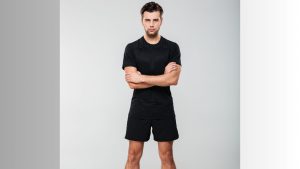
Understanding the Squat’s Impact
The Power of Squats: Squats are a compound exercise, targeting multiple muscle groups simultaneously. They primarily engage the quadriceps, hamstrings, glutes, and core muscles. For cyclists, this means potential benefits in generating power, improving pedal stroke efficiency, and stabilizing the lower body during rides.
Enhanced Strength and Power: Building lower body strength through squats can contribute to increased power output while pedaling. Stronger leg muscles mean more force applied with each stroke, potentially leading to better speed and endurance on the bike.
Frequency and Timing Matter
Balancing Act: While squats offer advantages, the frequency of training matters. For male cyclists aiming to integrate squats into their regimen, twice a week could strike a balance between reaping benefits and allowing for adequate recovery.
Consider Individual Needs: It’s crucial to acknowledge that every cyclist has unique requirements and fitness levels. Some may benefit from more frequent squat sessions, while others might find twice a week optimal.
Safety First: Proper Form and Support
Form is Key: Executing squats with improper form can lead to injuries. It’s vital to learn the correct technique or seek guidance from a fitness professional to prevent potential harm.

Complementary Training: Squats should be part of a comprehensive training plan that includes flexibility exercises, core workouts, and cycling-specific drills. This holistic approach supports overall performance improvement while reducing the risk of overtraining.
So.
Incorporating squats into the training routine of male cyclists can indeed contribute to enhancing their performance on the bike. However, the frequency of twice a week should be approached cautiously, considering individual fitness levels, recovery capacity, and the need for a well-rounded training program.
Remember, any training adjustments should be gradual, monitored, and tailored to individual needs. Before initiating any new exercise regimen, consulting a fitness professional or healthcare provider is advisable to ensure safety and efficacy in achieving performance goals.
Addressing Common Concerns and Maximizing Squat Benefits
Overcoming Misconceptions
Fear of Bulk: Some cyclists worry that incorporating squats might lead to bulky leg muscles, impacting their performance negatively. However, with controlled and targeted training, this concern is often unfounded. Cyclists can develop strength without significant muscle mass increase, optimizing power without compromising agility.
Optimizing Squat Sessions
Variety in Training: While squats are a fundamental exercise, variation in training is key. Introducing different types of squats (like front squats, goblet squats, or single-leg squats) can target specific muscle groups differently, promoting a more well-rounded strength development.
The Role of Recovery
Rest and Repair: Building strength isn’t just about exercising; recovery is equally vital. Adequate rest between squat sessions allows muscles to repair and grow stronger. Incorporating rest days and focusing on proper nutrition and hydration are crucial components of an effective training program.
Tailoring Workouts to Cycling Goals
Specificity in Training: For cyclists with particular goals (such as sprinting, hill climbing, or endurance races), tailoring squat variations and intensity can align more precisely with these objectives. For instance, higher reps with lighter weights might benefit endurance-focused cyclists, while heavier weights with lower reps could benefit sprinters.
Harnessing Squats for Cycling Success
Final Thoughts
Squats hold significant potential in boosting a male cyclist’s performance by enhancing lower body strength, power, and stability. When integrated thoughtfully and with a comprehensive training approach, they can be a valuable asset to a cyclist’s regimen.
By understanding the nuanced impact of squats and customizing workouts to individual needs and goals, male cyclists can harness the benefits without compromising their cycling abilities.
Remember, while squats can be advantageous, a holistic training plan that includes flexibility, core strength, and cycling-specific exercises is key to achieving peak performance on the bike.
External Resources:
The Benefits of Squats for Cyclists
Cycling Weekly: Strength Training for Cyclists
Effect of Resistance Training on Cycling Performance
The Benefits of Squats for Cyclists
Cycling Weekly: Strength Training for Cyclists
Effect of Resistance Training on Cycling Performance
When incorporating any new exercise routine, individual differences and specific fitness levels should be considered. Prioritizing safety, gradual progression, and professional guidance can ensure optimal results in enhancing cycling performance through squats.
Comparison tabular
| Aspect | Squats for Male Cyclists |
|---|---|
| Benefits | Enhances lower body strength, power, and stability |
| Primary Muscles | Quadriceps, hamstrings, glutes, and core muscles |
| Performance Impact | Increased power output, improved pedal stroke efficiency |
| Frequency | Twice a week for a balanced approach |
| Variation | Various types (front squats, goblet squats) for targeted training |
| Concerns | Misconception of bulky muscle development |
| Recovery Importance | Adequate rest for muscle repair and growth |
| Tailoring Workouts | Specificity to align with cycling goals |
| Holistic Approach | Complementary exercises for a well-rounded training program |
This comparison table outlines the benefits, considerations, and nuances associated with integrating squats into a male cyclist’s training routine, emphasizing the importance of a balanced approach and tailored workouts to optimize cycling performance.
Wrapping it up
In the realm of cycling, where every pedal stroke counts, the incorporation of squats into a male cyclist’s training regimen stands as a potential game-changer. The benefits they offer in enhancing lower body strength, power, and stability are undeniable.
However, the key lies not just in the exercise itself but in how it’s integrated. Embracing squats twice a week, with attention to form, variation, and recovery, can pave the way for improved cycling performance. It’s about finding that delicate balance between pushing limits and allowing adequate time for muscles to repair and grow stronger.
Remember, the road to cycling success isn’t solely paved by squats; it’s a comprehensive journey. A holistic training program encompassing flexibility, core strength, cycling-specific drills, and, yes, squats, forms the cornerstone of achieving peak performance.
So, male cyclists, while squats hold immense potential, they’re just one piece of the puzzle. Embrace them wisely, tailor workouts to your goals, and pedal towards cycling excellence, one squat at a time.
Happy cycling!

Hey there, it’s Mike Rrsq, the Editor-in-Chief over at Jsquat.com, and I’m absolutely obsessed with all things squat fitness! I’ve been lucky enough to get some serious recognition for my work in this field. With a solid background in the fitness and wellness industry, I’ve been there right from the get-go, helping shape this website into what it is today.
You see, I’m not just the boss around here; I’m also a passionate contributor. I love sharing my insights through my articles, and trust me, they’re not your run-of-the-mill stuff. Each piece I write is a labor of love, filled with my expertise and real-world experience in the fitness universe. So, if you’re into fitness and looking for some inspiration, you’re in the right place!
Related Posts
- Is incorporating isometric squats beneficial for improving running performance
Isometric squats, a form of exercise where you hold a position rather than moving through…
- The Importance of Front Squats for Male-Athlete Agility
When it comes to athletic performance, agility stands as a crucial pillar for success. For…
- Is incorporating squats with tempo beneficial for bodybuilding purposes
Absolutely, tempo squats can be a game-changer for bodybuilders looking to maximize their gains. The…
- Are Squats Recommended for 75-Year-Old Male Seniors?
As we age, maintaining mobility and strength becomes crucial for overall health. Exercise plays a…
- Is incorporating squats beneficial for relieving piriformis syndrome
Piriformis syndrome can be an uncomfortable and limiting condition, causing pain and discomfort in the…
- Is incorporating squats effective for relieving IT band syndrome.
Squats can be a helpful exercise for strengthening muscles around the hips and thighs, potentially…
- Is 100kg squats good for a 75 kg male?
Hey there, fitness enthusiasts! Ever wondered if squatting 100kg is a big deal for a…
- Is incorporating weight into squats recommended for overall fitness in seniors over 55
Absolutely. Squats, when done correctly and with proper guidance, can be beneficial for seniors over…
